Dachau concentration camp
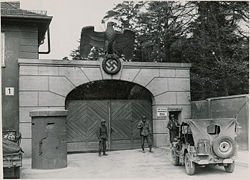

Dachau was a Nazi German concentration camp, and the first one opened in Germany, located on the grounds of an abandoned munitions factory near the medieval town of Dachau, about 16 km (10 miles) northwest of Munich in the state of Bavaria which is located in southern Germany.
Opened in March 1933[1], it was the first regular concentration camp established by the coalition government of National Socialist (Nazi) NSDAP party and the Catholic Zentrum party (dissolved on 6 July 1933). Heinrich Himmler, Chief of Police of Munich, officially described the camp as "the first concentration camp for political prisoners."[2]
Dachau served as a prototype and model for the other Nazi concentration camps that followed. Almost every community in Germany had members taken away to these camps, and as early as 1935 there were jingles warning:
- "Dear God, make me dumb, that I may not to Dachau come."[3]
Its basic organization, camp layout as well as the plan for the buildings were developed by Kommandant Theodor Eicke and were applied to all later camps. He had a separate secure camp near the command center, which consisted of living quarters, administration, and army camps. Eicke himself became the chief inspector for all concentration camps, responsible for molding the others according to his model.[4]
In total, over 200,000 prisoners from more than 30 countries were housed in Dachau of whom two-thirds were political prisoners and nearly one-third were Jews.[5] 25,613 prisoners are believed to have died in the camp and almost another 10,000 in its subcamps,[6] primarily from disease, malnutrition and suicide. In early 1945, there was a typhus epidemic in the camp followed by an evacuation, in which large numbers of the weaker prisoners died.
Together with the much larger Auschwitz, Dachau has come to symbolize the Nazi concentration camps to many people. Konzentrationslager (KZ) Dachau holds a significant place in public memory because it was the second camp to be liberated by British or American forces. Therefore, it was one of the first places where the West was exposed to the reality of Nazi brutality through firsthand journalist accounts and through newsreels.[7]
Contents[hide] |
Organization
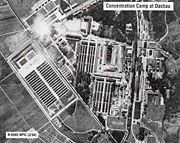
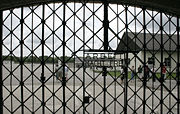
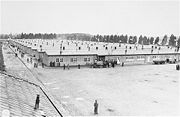
The camp was divided into two sections: the camp area and the crematorium. The camp area consisted of 32 barracks, including one for clergy imprisoned for opposing the Nazi regime and one reserved for medical experiments. The courtyard between the prison and the central kitchen was used for the summary execution of prisoners. The camp was surrounded by an electrified barbed-wire gate, a ditch, and a wall with seven guard towers.[4]
In early 1937, the SS, using prisoner labor, initiated construction of a large complex of buildings on the grounds of the original camp. Prisoners were forced to do this work, starting with the destruction of the old munitions factory, under terrible conditions. The construction was officially completed in mid-August 1938 and the camp remained essentially unchanged and in operation until 1945. Dachau thus was the longest running concentration camp of the Third Reich. The area in Dachau included other SS facilities beside the concentration camp—a leader school of the economic and civil service, the medical school of the SS, etc. The KZ at that time was called a "protective custody camp," and occupied less than half of the area of the entire complex.
Dachau also served as the central camp for Christian religious prisoners. According to records of the Roman Catholic Church, at least 3,000 preachers, deacons, priests, and bishops were imprisoned there.[8]
In August 1944 a women's camp opened inside Dachau. Its first shipment of women came from Auschwitz Birkenau. Only 19 women guards served at Dachau, most of them until liberation.[9][10]
In the last months of the war, the conditions at Dachau became even worse. As Allied forces advanced toward Germany, the Germans began to move prisoners in concentration camps near the front to more centrally located camps. They hoped to prevent the liberation of large numbers of prisoners. Transports from the evacuated camps arrived continuously at Dachau. After days of travel with little or no food or water, the prisoners arrived weak and exhausted, often near death. Typhus epidemics became a serious problem as a result of overcrowding, poor sanitary conditions, insufficient provisions, and the weakened state of the prisoners.
Owing to continual new transportations from the front, the camp was constantly overcrowded and the hygiene conditions were beneath human dignity. Starting from the end of 1944 up to the day of liberation, 15,000 people died, about half of all victims in KZ Dachau. Five hundred Soviet POWs were executed by firing squad.
On 24 April 1945 about 140 prominent inmates, such as Leon Blum, Martin Niemöller and Franz Halder, were transferred to Tyrol, where the SS left the prisoners behind. They were liberated by the Fifth U.S. Army on May 5, 1945 in Niederdorf, Italy[11].
On 27 April 1945 Victor Maurer, delegate of the International Committee of the Red Cross, was allowed to enter camps and distribute food. In the evening of the same day a prisoner transport arrived from Buchenwald. Only 800 survivors were brought from the original 4,480 to 4,800 prisoners in transit. Over 2,300 corpses were left lying in and around the train. The last regular commander of the KZ, Obersturmbannführer Eduard Weiter, had fled on 26 April. He probably followed Obersturmbannführer Martin Gottfried Weiss, who had led the camp from September 1942 until November 1943.
On 28 April 1945, the day before the surrender, Camp Commandant Martin Gottfried Weiss had left the Dachau camp, along with most of the regular guards and administrators in the camp. On that same day, Victor Maurer, a representative of the Red Cross, had tried to persuade Untersturmführer Johannes Otto, the adjutant of Commandant Weiss, not to abandon the camp, but to leave guards posted to keep the prisoners inside until the Americans arrived. Maurer feared that the prisoners would escape en masse and spread the active typhus fever epidemic. Lt. Otto declined to remain and fled.
Commanders
- SS-Standartenführer Hilmar Wäckerle (03.22.1933 - 06.26.1933)
- SS-Gruppenführer Theodor Eicke (06.26.1933 - 04.07.1934)
- SS-Oberführer Alexander Reiner (04.07.1934 - 10.22.1934)
- SS-Brigadeführer Berthold Maack (10.22.1934 - 01.12.1934)
- SS-Oberführer Heinrich Deubel (01.12.1934 - 03.31.1936)
- SS-Oberführer Hans Loritz (03.31.1936 - 01.07.1939)
- SS-Hauptsturmführer Alex Piorkowski (01.07.1939 - 01.02.1942)
- SS-Obersturmbannführer Martin Weiß (01.03.1942 - 09.30.1943)
- SS-Hauptsturmführer Wilhelm Weiter (09.30.1943 - 04.26.1945)
- SS-Obersturmbannführer Martin Weiß (04.26.1945 - 04.28.1945)
- SS-Untersturmführer Johannes Otto (04.28.1945 - 04.28.1945)
- SS-Sturmscharführer Heinrich Wicker (04.28.1945 - 04.29.1945)
Liberation

On 29 April 1945 the watchtowers of the Dachau camp remained occupied and a white flag was hoisted. Red Cross representative Maurer persuaded SS-Sturmscharführer Heinrich Wicker, an officer in the SS-Totenkopfverbände, to accompany him to the main gate of the complex to surrender the camp formally.
Late in the afternoon of 29 April 1945 KZ Dachau was surrendered to the American Army by SS-Sturmscharführer Heinrich Wicker.[12] A vivid description of the surrender appears in Brig. Gen. Henning Linden's official "Report on Surrender of Dachau Concentration Camp":
As we moved down along the west side of the concentration camp and approached the southwest corner, three people approached down the road under a flag of truce. We met these people about 75 yards north of the southwest entrance to the camp. These three people were a Swiss Red Cross representative and two SS troopers who said they were the camp commander and assistant camp commander and that they had come into the camp on the night of the 28th to take over from the regular camp personnel for the purpose of turning the camp over to the advancing Americans. The Swiss Red Cross representative acted as interpreter and stated that there were about 100 SS guards in the camp who had their arms stacked except for the people in the tower. He said he had given instructions that there would be no shots fired and it would take about 50 men to relieve the guards, as there were 42,000 half-crazed prisoners of war in the camp, many of them typhus infected. He asked if I were an officer of the American army, to which I replied, "Yes, I am Assistant Division Commander of the 42d Division and will accept the surrender of the camp in the name of the Rainbow Division for the American army."
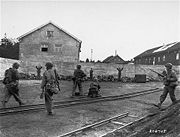
General Dwight D. Eisenhower, issued a communique over the capture of Dachau concentration "Our forces liberated and mopped up the infamous concentration camp at Dachau. Approximately 32,000 prisoners were liberated; 300 SS camp guards were quickly neutralized."[13]
One of the most ironic coincidences in the liberation of the sub-camps surrounding Dachau, occuring on the same day as the main camp's surrender on April 29, occurred when the advance scouts of the US Army's 522nd Field Artillery Battalion, a Nisei-manned segregated Japanese-American Allied military unit, liberated the 3,000 prisoners of the "Kaufering IV Hurlach" slave labor camp, an especially ironic coincidence because of the internment of relatives of Japanese ancestry, of the US Army's Nisei troops during the war.[1]

A tablet at the camp commemorates the liberation of Dachau by the 42nd Infantry Division of the U.S. Seventh Army on 29 April 1945. Other claim that the first forces to enter the main camp were a battalion of the 157th Infantry Regiment of the 45th Infantry Division commanded by Felix L. Sparks. There is an on-going disagreement as to which division, the 42nd or the 45th, actually liberated Dachau because they seem to have approached by different routes and by the American Army's definition, anyone arriving at such a camp within 48 hours was a liberator.[14] General Patton visited the Buchenwald camp after it was liberated, but not Dachau.
The Americans found approximately 32,000 prisoners, crammed 1,600 to each of 20 barracks, which had been designed to house 250 people each.
The American troops were so horrified by conditions at the camp that a few shot some of the camp guards after they had surrendered in what is called the Dachau massacre. The number massacred is disputed as some Germans were killed in combat, some were killed while attempting to surrender, and others were killed after their surrender was accepted. Felix L. Sparks, the commander of a battalion that captured the camp, has stated that "The total number of German guards killed at Dachau during that day most certainly not exceed fifty, with thirty probably being a more accurate figure. The regimental records [of the 57th Infantry Regiment] for that date indicate that over a thousand German prisoners were brought to the regimental collecting point. Since my task force was leading the regimental attack, almost all the prisoners were taken by the task force, including several hundred from Dachau".[15] The "[American Army] Investigation of Alleged Mistreatment of German Guards at Dachau" found that about 15 Germans were killed (with another 4 or 5 wounded) after their surrender had been accepted. Two other reports collated years after the incident put the figure between 122 and 520 Germans killed after their surrender had been accepted.[16]
As a result of the American Army investigation court-martial charges were drawn up against Sparks and several other men under his command, but as General Patton, the recently appointed military governor of Bavaria, chose to dismiss the charges so the witnesses to the massacre were never cross examined in court and no one was found guilty.[15]
The U.S. troops also forced citizens of the local community to come to the camp, observe the conditions, and help clean the facilities. Many local residents were shocked about the experience and claimed no knowledge of the camp's activities .
Post-liberation Easter at Dachau

A few days after the liberation of the camp was the day of Pascha, Orthodox Easter. In a cell block used by Catholic priests to say daily Mass, several Greek, Serbian, and Russian priests and one Serbian deacon, wearing makeshift vestments made from towels of the SS guard, gathered with several hundred Greek, Serbian and Russian prisoners to celebrate the Paschal Matins and Liturgy. A prisoner named Rahr described the scene:
In the entire history of the Orthodox Church there has probably never been an Easter service like the one at Dachau in 1945. Greek and Serbian priests together with a Serbian deacon adorned the make-shift 'vestments' over their blue and gray-striped prisoners' uniforms. Then they began to chant, changing from Greek to Slavonic, and then back again to Greek. The Easter Canon, the Easter Sticheras—everything was recited from memory. The Gospel—In the beginning was the Word—also from memory. And finally, the Homily of Saint John—also from memory. A young Greek monk from the Holy Mountain stood up in front of us and recited it with such infectious enthusiasm that we shall never forget him as long as we live. Saint John Chrysostomos himself seemed to speak through him to us and to the rest of the world as well!

There is a Russian Orthodox chapel at the camp today, and it is well known for its exquisite icon of Christ leading the prisoners out of the camp gates.
The U.S. 7th Army's version of the events of the Dachau Liberation are available in Report of Operations of the Seventh United States Army, Vol. 3, page 382.
After liberation
After liberation, the camp was used by the US Army as an internment camp. It was also the site of the Dachau Trials, a site chosen for its symbolism. In 1948 the Bavarian government established housing for refugees on the site, and this remained for many years.[17] Dachau is depicted as the setting for The Twilight Zone episode Deaths-Head Revisited in which a former Nazi captain revisits the place he once worked in and the ghosts of the men who died there.
The memorial site
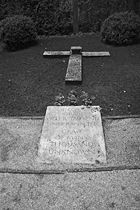
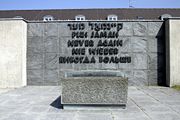
Between 1945 and 1948 when the camp was handed over to the Bavarian authorities, many accused war criminals and members of the SS were imprisoned at the camp.
Owing to the severe refugee crisis mainly caused by the expulsions, the camp was from late 1948 used to house 2000 Germans from Czechoslovakia (mainly from the Sudetenland). This settlement was called Dachau-East, and remained until the mid 60's.[18] During this time, former prisoners banded together to erect a memorial on the site of the camp, finding it unbelievable that there were still people (refugees) living in the former camp.
The display, which was reworked in 2003, takes the visitor through the path of new arrivals to the camp. Special presentations of some of the notable prisoners are also provided. Two of the barracks have been rebuilt and one shows a cross-section of the entire history of the camp, since the original barracks had to be torn down due to their poor condition when the memorial was built. The other 32 barracks are indicated by concrete foundations.
The memorial includes four chapels for the various religions represented among the prisoners.
The local government resisted designating the complete site a memorial. The former SS barracks adjacent to the camp are now occupied by the Bavarian Bereitschaftspolizei (rapid response police unit).[19]
Notable prisoners of Dachau
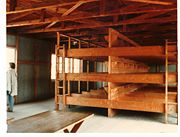
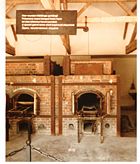
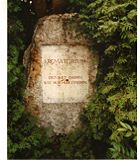
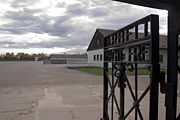
Jewish political prisoners
- Bruno Bettelheim, imprisoned in 1938, freed in 1939; left Germany
- David Ludwig Bloch, painter, arrested in November 1938 in connection with Kristallnacht
- Jakob Ehrlich, Member of Vienna's City Council (Rat der Stadt Wien), died in Dachau 17 May 1938
- Viktor Frankl, neurologist and psychiatrist from Vienna, Austria
- Alfred Gruenebaum, father of the prominent US obstetrician Amos Grunebaum
- The mother and father of Rush frontman Geddy Lee
- Hans Litten anti-Nazi lawyer, died in 1938 by apparent suicide
- Aaron Miller, rabbi, chazzan, mohel
- Benzion Miller, born at the camp, son of Aaron*
- Moshe Sanbar, Governor of the Bank of Israel
- Vladek Spiegelman, a survivor whose story was portrayed in the book Maus by son Art Spiegelman
Resistance fighters
- Yolande Beekman, Special Operations Executive Agent, murdered 13 September 1944
- Georges Charpak, who in 1992 received the Nobel Prize in Physics
- Madeleine Damerment, Special Operations Executive Agent, murdered 13 September 1944
- Georg Elser, who tried to assassinate Hitler in 1939, murdered April 9 1945
- Arthur Haulot
- Franc Karo, partisan
- Noor Inayat Khan, the George's Cross awardee of Indian origin who served as a clandestine radio operator for the Special Operations Executive in Paris, murdered 13 September 1944 when she and her SOE colleagues were shot in the back of the head and cremated
- Kurt Nehrling, murdered in 1943
- Eliane Plewman, Special Operations Executive Agent, murdered 13 September 1944
Clergy
Dachau had a special "priest block." Of the 2720 priests (among them 2579 Catholic) held in Dachau, 1034 did not survive the camp. The majority were Polish (1780), of whom 868 died in Dachau.
- a number of the 108 Martyrs of World War Two:
- Father Jean Bernard (1907-1994), Catholic priest from Luxembourg who was imprisoned from May, 1941 to August, 1942. He wrote the book Pfarrerblock 25487 about his experiences in Dachau; it was recently translated into English (translation Priestblock 25487: A Memoir of Dachau ISBN 978-0972598170). The movie "The Ninth Day" is based on his diary.
- Blessed Titus Brandsma, Dutch Carmelite priest and professor of philosophy, died 26 July 1942
- Norbert Čapek (1870-1942) founder of the Unitarian Church in the Czech Republic
- Anton Fränznick, in Dachau since 1942, died 27 January 1944
- Blessed Stefan Wincenty Frelichowski Catholic priest, died 23 February 1945
- Blessed Stefan Grelewski, Catholic priest, prisoner No. 25281, starved to death in Dachau on 9 May 1941
- Hilary Paweł Januszewski
- Joseph Kentenich, founder of the Schoenstatt Movement, spent three and a half years in Dachau
- Hermanus Knoop, Pastor of the Reformed (Gereformeerd) Church of Rotterdam-Delfshaven, arrested 19 November 1941 for praying for "bringing politics to the pulpit"
- Blessed Michał Kozal
- Adam Kozlowiecki, Polish Cardinal
- Max Lackmann, Lutheran pastor and founder of League for Evangelical-Catholic Reunion.
- Blessed Karl Leisner, in Dachau since 14 December 1941, freed 4 May 1945, but died on 12 August from the tuberculosis contracted in the camp
- Martin Niemöller, imprisoned in 1941, freed 4 May 1945
- Hermann Scheipers
- Richard Schneider, in Dachau since 22 November 1940, freed 29 March 1945
- Aloys Scholze, died 1 September 1942
- Nikolai Velimirović (1880-1956), Serbian bishop and an influential theological writer, On 14 December 1944 he was sent to Dachau, together with Serbian Patriarch Gavrilo
- Lawrence Wnuk
- Nanne Zwiep, Pastor of the Dutch Reformed Church in Enschede, spoke out from the pulpit against Nazis and their treatment of Dutch Citizens and anti-Semitism, arrested 20 April 1942, died in Dachau of exhaustion and malnutrition 24 November 1942
Politicians
- Jan Buzek, murdered in November 1940
- Leopold Figl, arrested 1938, released 8 May 1943
- Alois Hundhammer, arrested 21 June 1933, freed 6 July 1933
- Hjalmar Schacht, arrested 1944, released April 1945
- Kurt Schumacher, in Dachau since July 1935, sent to Flossenbürg concentration camp in 1939, returned to Dachau in 1940, released due to extreme illness 16 March 1943
- Kurt Schuschnigg, the last fascist chancellor of Austria before the Austrian Nazi Party was installed by Hitler, shortly before the Anschluss
- Stefan Starzyński, the President of Warsaw, probably murdered in Dachau in 1943
Communists
- Alfred Andersch, held 6 months in 1933
- Hans Beimler, imprisoned but escaped. Died in the Spanish Civil War.
- Emil Carlebach (Jewish), in Dachau since 1937, sent to Buchenwald concentration camp in 1938
- Nando Gherghetta (Italian-Istrian), from 1943
- Alfred Haag, In Dachau from 1935 to 1939, when moved to Mauthausen
- Adolf Maislinger
- Oskar Müller, in Dachau from 1939, freed 1945
- Nikolaos Zachariadis (Greek), from November 1941 to May 1945
Writers
- Fran Albreht, Slovenian poet
- Robert Antelme, French writer
- Raoul Auernheimer, writer, in Dachau 4 months
- Tadeusz Borowski, writer, survived, but committed suicide in 1951
- Adolf Fierla, Polish poet
- Viktor Frankl, an Austrian psychiatrist and writer
- Fritz Gerlich
- Stanisław Grzesiuk, Polish writer, poet and singer, Varsavianist, in Dachau since 4 April 1940, later transferred to Mauthausen-Gusen complex
- Heinrich Eduard Jacob, German writer, in Dachau 6 months in 1938, transferred to Buchenwald
- Stefan Kieniewicz, Polish historian
- Juš Kozak, Slovenian playwright
- Gustaw Morcinek, Polish writer
- Boris Pahor, Slovenian writer
- Karol Piegza, Polish writer, teacher and folklorist
- Gustaw Przeczek, Polish writer and teacher
- Franz Roh, German art critic and art historian, for a few months in 1933
- Jura Soyfer, writer, in Dachau 6 months in 1938, transferred to Buchenwald
- Adam Wawrosz, Polish poet and writer
- Stanislaw Wygodzki, Polish writer
- Stevo Žigon (number: 61185), Serbian actor, theatre director, and writer, in Dachau from December 1943 to May 1945
Royalty
- Antonia, Crown Princess of Bavaria
- Rupprecht, Crown Prince of Bavaria
- Albrecht, Duke of Bavaria
- Franz, Duke of Bavaria
- Prince Max, Duke in Bavaria
- Franz Wittelsbach, Prinz von Bayern
- Maximilian, Duke of Hohenberg
- Prince Ernst von Hohenberg
- Princess Sophie of Hohenberg
- Prince Xavier de Bourbon-Parma
Others
- Charles Delestraint, French General and leader of French resistance. Executed by Gestapo in 1945
- Elly Gotz, Lithuanian born engineer and executive, now living in Canada doing public speaking to raise awareness about modern day genocides happening in places such as Darfur. She was born in Kovno (now Kaunas), Lithuania in 1902.
- Franz Halder, former Chief of Army General Staff
- Boris Kobe, Slovenian architect
- Zoran Mušič, Slovenian painter
- Božo Pengov, Slovenian sculptor
- Fritz Thyssen, businessman and early supporter of Hitler, later an opponent
- Bogislaw von Bonin, Wehrmacht officer, opponent
- Stevo Žigon, a famous Serbian actor, theatre director, and writer. His prisoner number was 61185
Gallery
See also
- Dachau Trials
- List of Nazi-German concentration camps
- List of subcamps of Dachau
References
- ↑ The Dachau Gas Chambers: Photograph 2 - Münchner Neueste Nachrichten (The Munich Latest News), March 21, 1933
- ↑ http://www.mazal.org/archive/DACHPHO/Dach02.htm Translation: The Munich Chief of Police, Himmler, has issued the following press announcement: On Wednesday the first concentration camp is to be opened in Dachau with an accommodation for 5000 persons. All Communists and—where necessary—Reichsbanner and Social Democratic functionaries who endanger state security are to be concentrated here, as in the long run it is not possible to keep individual functionaries in the state prisons without overburdening these prisons, and on the other hand these people cannot be released because attempts have shown that they persist in their efforts to agitate and organise as soon as they are released.
- ↑ Morris Janowitz "German Reactions to Nazi Atrocities", 1946, (JSTOR)
- ↑ 4.0 4.1 United States Holocaust Memorial Museum. "The Holocaust." Holocaust Encyclopedia. http://www.ushmm.org/wlc/article.php?lang=en&ModuleId=10005214
- ↑ "Dachau - The First Concentration Camp". Archived from the original on 2006-01-04.
- ↑ That Was Dachau 1933 - 1945 by Stanislav Zámečník Page 377 and 379
- ↑ Among the most famous inmates of the Dachau concentration camp were Hans Litten, Fred Rabinowitz (a.k.a. Fred Roberts), Stefan Starzynski, the composer Blaž Arnič and Alfred Gruenebaum, the father of a prominent U.S. obstetrician, Amos Grunebaum.
- ↑ Particularly notable among the Christian residents are Karl Leisner (Catholic priest ordained while in the camp, beatified by Pope John Paul II in 1996) and Martin Niemöller (Protestant theologian and Nazi resistance leader).
- ↑ THE CAMP WOMEN, The Female Auxiliaries who Assisted the SS in Running the Nazi Concentration Camp System by Daniel Patrick Brown.
- ↑ Sources show the names of sixteen of the nineteen women guarding the camp; Fanny Baur, Leopoldine Bittermann, Ernestine Brenner, Anna Buck, Rosa Dolaschko, Maria Eder, Rosa Grassmann, Betty Hanneschaleger, Ruth Elfriede Hildner, Josefa Keller, Berta Kimplinger, Lieselotte Klaudat, Theresia Kopp, Rosalie Leimboeck, and Thea Miesl. Women guards were also staffed at the Augsburg Michelwerke, Burgau, Kaufering, Muhldorf, and Munich Agfa Camera Werke subcamps. In mid-April 1945 many female subcamps at Kaufering, Augsburg and Munich closed, and the SS women stationed at Dachau. It is reported that female SS guards gave prisoners guns before liberation to save them from postwar prosecution.
- ↑ georg-elser-arbeitskreis.de (German)
- ↑ 2nd Lt. Heinrich Wicker, the man who surrendered the Dachau concentration camp, 29 April 1945
- ↑ Staff, quoting Abram Sachar on The Liberation of Dachau, Nizkor Project.
- ↑ Albert Panebianco (ed). Dachau its liberation 57th Infantry Association, Felix L. Sparks, Secretary 15 June 1989. (backup site) Cites a letter by James R. Bird to Joseph I. Lieberman
- ↑ 15.0 15.1 Albert Panebianco (ed). Dachau its liberation 57th Infantry Association, Felix L. Sparks, Secretary 15 June 1989. (backup site)
- ↑ Staff. A review of Col. Howard A. Buechner's account of execution of Waffen-SS soldiers during the liberation of Dachau, Scrapbookpages.com, 28 July, 2006
- ↑ Dachau Concentration Camp Memorial Site (pedagogical information) (German)
- ↑ Legacies of Dachau: The Uses and Abuses of a Concentration Camp, 1933-2001 Harold Marcuse
- ↑ Sven Felix Kellerhoff (2002-10-21). "Neue Museumskonzepte für die Konzentrationslager" (in German), WELT ONLINE, Axel Springer AG. Retrieved on 2008-06-02. ". . . die SS-Kasernen neben dem KZ Dachau wurden zuerst (bis 1974) von der US-Armee bezogen. Seither nutzt sie die VI. Bayerische Bereitschaftspolizei. (. . . the SS barracks adjacent to the Dachau concentration camp were at first occupied by the US Army (until 1974) . Since then they have been used by the Sixth Rapid Response Unit of the Bavarian Police.)"
- Buechner, Howard A., Dachau—The Hour of the Avenger, Thunderbird Press, ©1986, paperback, 159 pages, ISBN 0-913159-04-2, first published in 1986. LC Control Number: 87181873.
- Kozal, Czesli W. Memoir of Fr. Czesli W. (Chester) Kozal, O.M.I. / translated from the Polish original by Paul Ischler. Private printing, Missionary Oblates of Mary Immaculate, 2004, 175 pp. LC Control Number: 2004400050
- Marcuse, Harold, Legacies of Dachau: The Uses and Abuses of a Concentration Camp, 1933-2001, 600 pages, Cambridge University Press, 2001. more information
- The Fighting Forty-Fifth: the Combat Report of an Infantry Division, compiled and edited by Lt. Col. Leo V. Bishop, Maj. Frank J. Glasgow, and Maj. George A. Fisher. Copyright 1946 by the 45th Infantry Division, printed by Army & Navy Publishing Co., Baton Rouge, LA. LC Control Number: 49051541.
External links
- Dachau Concentration Camp Memorial Site Official Page
- Dachau 67 page comprehensive report prepared by the 7th Army in 1945
- Dachau Concentration Camp Memorial Site Links, essays and documents by Professor Harold Marcuse, author of Legacies of Dachau, a comprehensive history of the camp and memorial site
- scrapbookpages.com offers a richly illustrated, historically comprehensive overview of the camp
- Communists to be interned in Dachau, The Guardian, March 21 1933 contemporaneous report on the opening of the camp
- Interior and exterior images of the Dachau camp
- Events of the Dachau Camp's liberation on April 29th, 1945 at humanitas international
- "The Souls are All Aflame." An account of the Paschal services in Dachau in 1945
- Memorial to those who suffered at the eleven Kaufering subcamps of Dachau and to the US 12th Armored Division (a personal website)
- Biography of survivor Abram Enzel (personal website by his son)